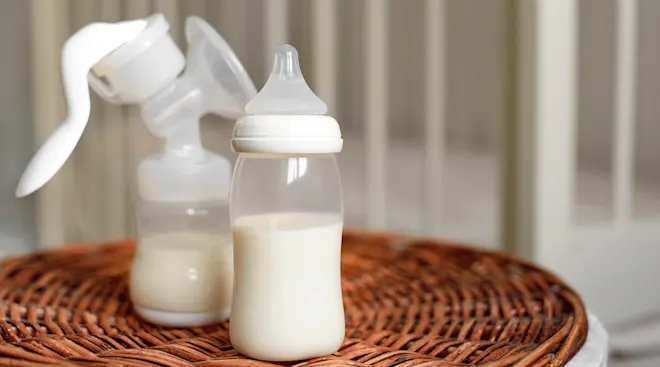How to “Dream Feed” Baby
In their first few months of life, babies tend to be hungry all the time. This is one of the reasons many babies wake up multiple times a night (and wake you up too!). In an attempt to avoid repeated bleary-eyed middle-of-the-night feeds, some parents have implemented the dream feed—essentially feeding baby earlier in the night, while they’re mostly asleep, in hopes of preventing that exhausting 2 a.m. wakeup.
While dream feeding is a game-changer for many families, it can also be unpredictable and tricky to do correctly. And since every baby’s different, it’s possible that the dream feed won’t make that much of a difference for you. But if you’re desperate for a few consecutive hours of sleep, learning how to dream feed your little one may just be worth a try. Read on to learn more about the dream feed, including how to do it right.
A dream feed essentially means feeding baby just before you yourself plan to go to sleep, says Anthony Hudson, MD, a pediatrician with Children’s Hospital New Orleans. “This is done in hope of shifting an infant’s sleep schedule to reflect that of the parents,” he says. That way, you’ll (hopefully) prevent night wakeups and get yourself more consecutive hours of sleep.
During a dream feed, baby generally remains asleep, explains Demi Lucas, IBCLC-RLC, a lactation consultant and clinical resource manager at The Lactation Network. “Baby may fully wake themselves at other night feeds and then rouse the parents for the feed. A dream feed would be initiated by the parent, and [the] infant would generally remain asleep throughout most of the feed.”
The dream feed isn’t for newborns—experts advise waiting until baby’s at least a few weeks old to implement the method. “Newborns feed every two to three hours for the first month of life,” says Hudson. “If a family wants to try a dream feed, I suggest waiting six to eight weeks of life for a [full-term] newborn.”
This aligns with guidance from the American Academy of Pediatrics (AAP), which says that parents should feed both breastfed and formula-fed newborns on demand, and that it can take time for baby to develop a regular feeding schedule.
Make sure to speak with a pediatrician and/or a lactation consultant before starting a dream feed, since every family’s situation—and every baby—is unique.
Dream feeding involves “lightly rousing [baby] and eliciting the rooting reflex, and allowing baby to latch and feed while they’re still lightly sleeping,” Lucas explains.
Hudson suggests dream feeding baby about 30 minutes before your own bedtime. He also recommends keeping the room as dark or dimly lit as possible. Place baby back in their crib or bassinet as soon as you’re done with the dream feed, he adds.
When done correctly, dream feeding can help tired parents get more unbroken hours of sleep—and, let’s face it, sleep deprivation is a huge issue for new parents.
“The benefits of dream feeding are primarily in line with the goal of extending the stretch of time a parent may get to sleep,” says Lucas. “If a parent decides to nurse their baby before they themselves go to bed, it may lengthen the time between then and the next feed, allowing for the parent to get more rest. This is a delicate process, however, depending on the age of baby, the parent milk supply, and needs or goals.”
Both Hudson and Lucas say that there are minimal risks involved with a dream feed. However, because babies are unpredictable, there’s always the possibility that things could backfire. “It may lead to the infant not wanting to go back to bed,” Hudson points out.
Lucas says there are special considerations for breastfeeding moms when dream feeding. “If the infant doesn’t fully empty the breast at the feed due to inactive feeding during these feeds, pay attention to fullness of the breasts and any areas that may not have drained well,” she says.
There’s no set time when parents should stop offering a dream feed—this depends on your family’s needs. “I would recommend to stop this behavior when the parents are ready,” Hudson says. You can work with your pediatrician and/or lactation consultant to figure out when to drop the dream feed.
Frequently Asked Questions
How can I get baby back to sleep after a dream feed?
Ideally, your little one isn't fully awake for the dream feed. “The infant should still be drowsy enough to easily return to sleep after the feed,” Lucas says. After feeding them, place them back in their sleep space—on their back, as per safe sleep guidelines, says Hudson.
Is it okay if baby doesn’t burp after a dream feed?
It’s not entirely necessary for baby to burp after a dream feed, both Hudson and Lucas say. However, if baby tends to spit up a lot or gets gas or reflux, they should be burped.
A dream feed can be a great way to keep baby fed, and to give yourself a longer and more comfortable night of sleep. That said, it’s important to make sure baby’s ready—and to keep in mind that every baby will respond to a new routine differently.
Please note: The Bump and the materials and information it contains are not intended to, and do not constitute, medical or other health advice or diagnosis and should not be used as such. You should always consult with a qualified physician or health professional about your specific circumstances.
Plus, more from The Bump:
Anthony Hudson, MD, is a pediatrician with Children’s Hospital New Orleans. He also serves as the chief of pediatrics at East Jefferson General Hospital in Metairie, Louisiana. He received his medical degree from Louisiana State University School of Medicine.
Demi Lucas, IBCLC-RLC, is a lactation consultant and clinical resource manager at The Lactation Network.
Healthy Children (American Academy of Pediatrics), Amount and Schedule of Baby Formula Feedings, May 2022
Learn how we ensure the accuracy of our content through our editorial and medical review process.
Navigate forward to interact with the calendar and select a date. Press the question mark key to get the keyboard shortcuts for changing dates.




















































